The release of the prize-winning documentary 'The Cove' is once more focusing world wide attention on dolphin killing in Japan and the capture of dolphins for dolphinariums.
But little of the coverage refers to the history of the subject. It is important that people realise that this is a battle that has been going on for 30 years or more. This post pays tribute to the pioneer protestors.
'The Cove' focuses on the killings on Iki Island, a topic we covered in the book we produced in the early 1990s - The Greenpeace Book of Dolphins (see Previous Post: DOLPHINS REVISITED). This is part of what we wrote for the book at that time:
'The battle between dolphins and the fishermen of Katsumoto in Iki island... dates back to the early part of the twentieth century. It was then that dolphins were first blamed for disturbing the breeding grounds of the yellowtail, the islanders' main fish catch. The killing of the dolphins remained sporadic, however, until 1976 when yellowtail catches declined and the fishermen protested that it was because of an increased population of dolphins in the area....Between 1976 and 1982, the Iki islanders killed at least 4,147 bottlenose dolphins, 953 false killer whales, 525 Risso's dolphin and 466 Pacific white-sided dolphins.'
Back in 1989 we produced The Greenpeace Story, an official history of Greenpeace which was published by Dorling Kindersley. [See Previous Post: GREENPEACE: THE RETURN TO AMCHITKA]
Blood Bath Trapped in the Japanese slaughter pens, dozens of dolphins are hacked to death. The shocking sight of this massacre spurred Dexter Cate and Patrick Wall into action.
Dolphin Massacre
Three notable actions by Greenpeace activists in Japan, in protest against the killing of whales and dolphins, hit the headlines between 1979 and 1981.
Early Greenpeace days in Vancouver with Paul Spong (who first got Greenpeace involved with whales via a group called Project Jonah) and Dexter Cate at far right. [Source: Quad meme blog]
'In 1978, US environmentalist Dexter Cate first witnessed the destruction of over 1,300 dolphins by fishermen on the Izu Peninsula, 200 kilometres (120 miles) southwest of Tokyo. It was a sight he was unlikely to forget.
He arrived to find some 300 dolphins penned in nets at the harbour mouth. The water in the harbour was red with blood, following an earlier round-up. As he watched, a fisherman in one of the boats surrounding the nets hurled a spear into the milling dolphins, piercing one of them. This random wounding served to keep the dolphins in a state of panic and confusion, and prevented them from escaping since they will not abandon an injured member of their group.
A dozen dolphins at a time were then winched ashore by their tails. What followed was horrific, as the fishermen went to work with their knives. "Dolphins with bellies slit open thrashed about, whistling in distress as their entrails flopped on the concrete. They didn't lose consciousness even as blood gushed from their throats. As we stood there, horrified witnesses, a fisherman deftly severed the heart from a still quivering dolphin and tossed it aside. It landed less than a yard from my feet, still beating."
The corpses were later dragged to a mincing machine and the flesh was ground up for use as pig food and plant fertilizer.
Cate learned that the dolphins were being held responsible for the alarming decline of yellowtail fish and squid, but he was certain that pollution and overfishing were to blame. When he returned to Japan late in 1979, he discovered that the government now encouraged the killing and were paying a bounty of $80 per head. It was then that Cate turned to civil disobedience.
In the early hours of February 28, 1980, Cate paddled a small inflatable boat out to Tatsunoshima (Dragon Island), an islet in the bay 800 metres (2,600 feet) off Iki Island, where he untied three ropes and cut a fourth to release 300 dolphins. When the fishermen returned to their nets, Cate recalls: 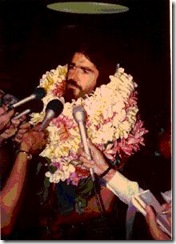 "They were angry, but not abusive. They understood, finally, that I had acted from a moral position. They just didn't understand that position."
"They were angry, but not abusive. They understood, finally, that I had acted from a moral position. They just didn't understand that position."
Neither did a Japanese court. Following his arrest, Cate was charged with criminal damage and denied bail. He spent three months in jail before being given a suspended six-month sentence and deported to his home in Hawaii.'
PHOTO: Dexter was honoured for his action on his return to Hawaii. [Source: Earthtrust]
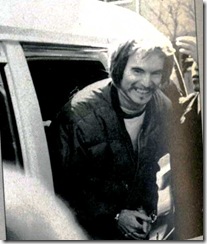 Greenpeace member Patrick Wall was shocked by what he saw when he travelled to Japan in November 1980 to research the dolphin slaughter at Izu, south of Tokyo. Here dolphins were killed for food every week during the season. In January 1981, he managed to dismantle 15 metres (50 feet) of the net barricading the slaughter pens and release 150 dolphins before daybreak. Two days later he gave himself up to the authorities; after three trials and 62 days in prison, he was given a suspended six-month sentence, a three-year probation and told that he couldn't return to Japan for one year.'
Greenpeace member Patrick Wall was shocked by what he saw when he travelled to Japan in November 1980 to research the dolphin slaughter at Izu, south of Tokyo. Here dolphins were killed for food every week during the season. In January 1981, he managed to dismantle 15 metres (50 feet) of the net barricading the slaughter pens and release 150 dolphins before daybreak. Two days later he gave himself up to the authorities; after three trials and 62 days in prison, he was given a suspended six-month sentence, a three-year probation and told that he couldn't return to Japan for one year.'
Read Dexter Cate's own account in 'The Island of the 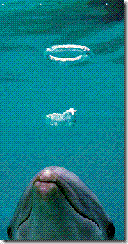 Dragon' /PETER SINGER (ed), In Defense of Animals
Dragon' /PETER SINGER (ed), In Defense of Animals
New York: Basil Blackwell, 1985, pp. 148-156
Hardy Jones founded Bluevoice.org with actor Ted Danson and continues to campaign to save dolphins. Read his account of the Iki campaign on his blog bluevoicenews
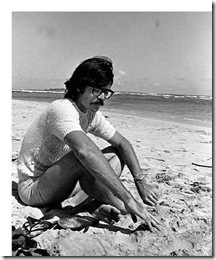
Dexter Cate drowned while ascending from a deep free dive in the waters near Hawaii. in 1990.
Dexter at Laie, Oahu 1974 photo courtesy of Ian Lind
DO NOT KILL WHALES OR DOLPHINS: A 2008 Visual Petition by Minds In The Water.
An animal rights activist covered in red paint lies on a white sheet made to look like a Japanese flag during a protest against dolphin slaughter in Madrid, Sept. 3, 2008. (Susana Vera/Reuters)
Latest News:
Ric O'Barry talks about The Cove: The former dolphin trainer's life changed the day one of his charges appeared to commit suicide by Jacqui Goddard.
Source: The Times/16th October 2009
Taiji tests residents' hair to gauge mercury levels from dolphin meat
By MINORU MATSUTANI/The Japan Times/15th October 2009
In Japan, fishermen round up and slaughter hundreds and even thousands of dolphins and other small whales each year /SaveJapanDolphins.org
'It is commonly assumed that Japanese fishermen hunt dolphins to supply a small minority of Japanese people with dolphin meat. But unlike the expensive whale meat, dolphin meat is not considered a delicacy in Japan, and the real reason the Japanese government issues permits to kill dolphins by the thousands every year has nothing to do with food culture. It has to do with pest control. As shocking as it sounds, some Japanese government officials view dolphins as pests to be eradicated in huge numbers. During a meeting at Taiji City Hall, the fishermen of Taiji admitted this to us. "We don’t kill the dolphins primarily for their meat. We kill them as a form of pest control," they told us. In other words, killing the competition is their way of preserving the ocean’s fish for themselves. '
Source: Earth Times/12th October
Sea of blood as Japan slaughters thousands of dolphins by Mick Brown/Telegraph 3rd Oct 2009.
Every year, thousands of dolphins are herded into a tranquil cove in Japan where some are captured for sale to marine parks, the rest slaughtered for their meat.
"It's Dante's Inferno for dolphins" By Justin McCurry - GlobalPost /September 25, 2009
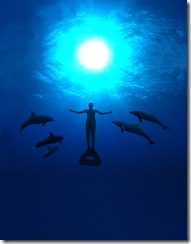
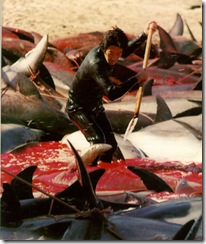
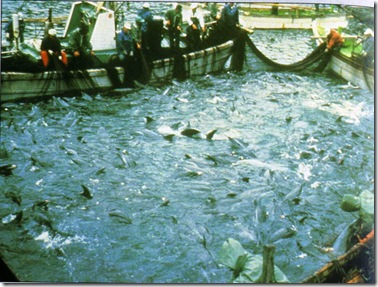
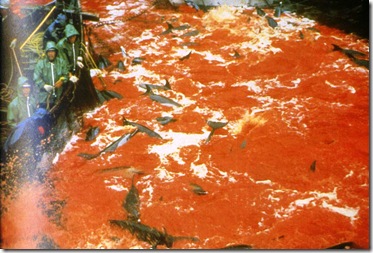



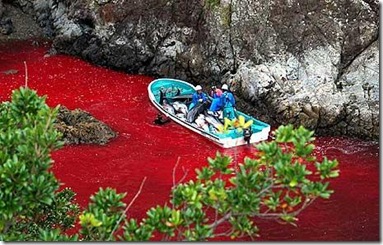
1 comment:
I feel we MUST refocus. ONLY the Japanese people can stop this. THe more Japanese nationals you have fighting for the rights of those dolphins the quicker this will end.
Post a Comment